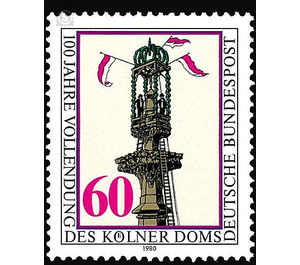100th anniversary of the completion of Cologne Cathedral - Germany / Federal Republic of Germany 1980 - 60 Pfennig
| Country | Germany / Federal Republic of Germany |
| Issue Date | 1980 |
| Face Value | 60.00 |
| Color | white |
| Perforation | K 14 |
| Printing Type | Six-color offset printing |
| Stamp Type | Postage stamp |
| Item Type | Stamp |
| Chronological Issue Number | 951 |
| Chronological Chapter | GER-BRD |
| Michel ID | BRD 1064 |
| SID | 838555 |
| In 58 Wishlists | |
On October 15, 1880, the Cologne Cathedral was completed after a construction period of exactly 632 years and two months by placing the keystone of the finial of the South Tower in 157 m height. This was one of the boldest construction projects in European architectural history has been completed. The fact that such a work was created in Cologne, of all places, can only be explained from history. Even before the Edict of Milan, which granted a general freedom of belief in the Roman Empire in 313, there was a Christian sanctuary on the site of the cathedral, from which a bishop's church developed during the 4th century. At the time of Charlemagne, the construction of a mighty cathedral began and consecrated it on September 27, 870 in honor of Sts. Peter and the Blessed Mother. The increase of power and influence of the Archbishop of Cologne in spiritual and secular territory, as well as the growing pilgrimage to the Magi, which rested in the Dome since 1164, brought with it the decision in 1248, a completely new one To build a church in the style of the then high Gothic cathedrals of France. On 15 August 1248 laid the foundation stone. In 1322 it was possible to use the 45 m high choir. But then the pace slowed down. After all, in 1560, when the works were completely shut down, ninety percent of the floor space was under roof, but large parts were still missing, especially the towers, of which only the southern had reached a height of 55 m. After some futile impulses in the baroque it was above all Sulpiz Boisserée, who through his monumental copper engraving "Views, cracks and individual parts of the cathedral of Cologne" carried the dome-thoughts into the public eye. After Joseph Görres in 1814 had demanded to complete the cathedral as a national monument, these ideas were common property of the German people. In 1842, the Prussian King Friedrich Wilhelm IV, together with the later Cardinal von Geissel, laid the foundations for further construction. The cost initially contributed the king and the bourgeois Central Dombau club each half, until then towards the end of the construction period, the share of the club grew steadily and last reached over 85%. 1863 was the interior, in 1880 were finally completed the towers, then the tallest buildings in the world. For the completion ceremony, which was committed with great effort, Kaiser Wilhelm I. appeared personally. However, the Archbishop of Cologne, Paul Melchers, lived in exile as a result of the Kulturkampf and was not even allowed to enter German soil for the Dombaufest. (Text: Cathedral administration of the Metropolitan Chapter in Cologne)
| Condition | Name | In Stock | Price | Price + Shipping | Store | |
|---|---|---|---|---|---|---|
 | Unmounted Mint ** | 100th anniversary of the completion of Cologne Cathedral - Germany / Federal Republic of Germany 1980 - 60 Pfennig | 10 | US $0.641 | US $3.84 |  FILATELIELOKET (0) FILATELIELOKET (0)Shipping US $3.20 Minimum Order US $2.67 |


